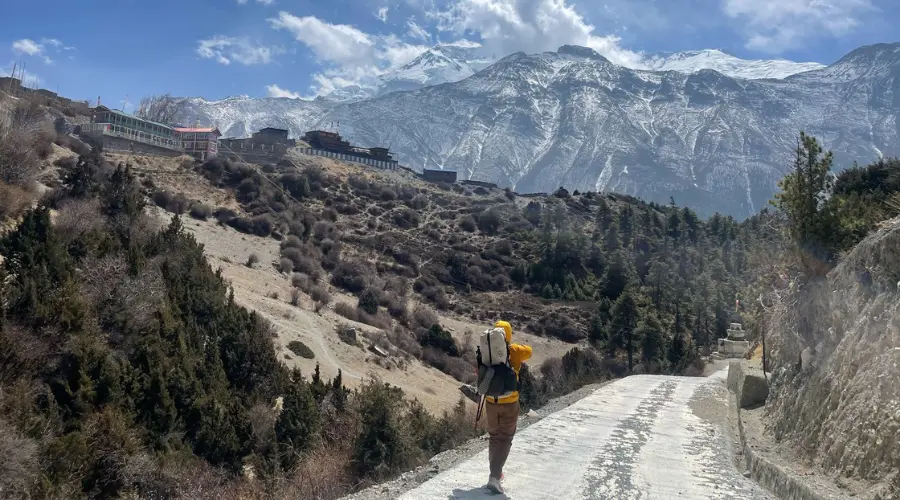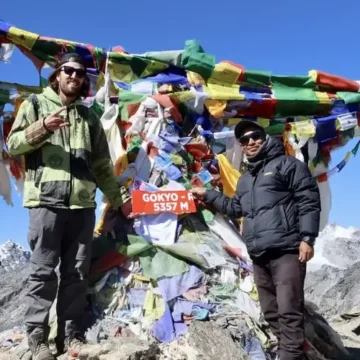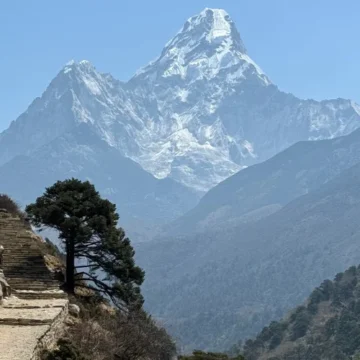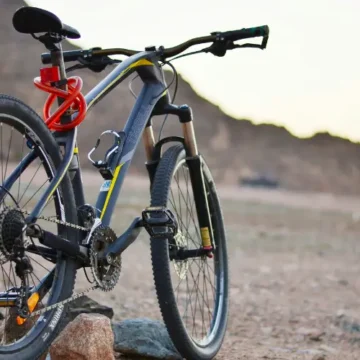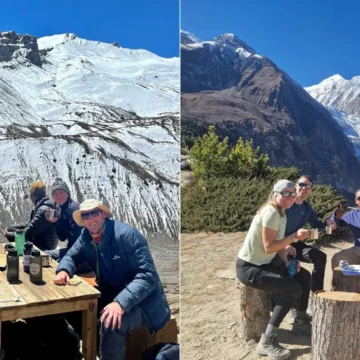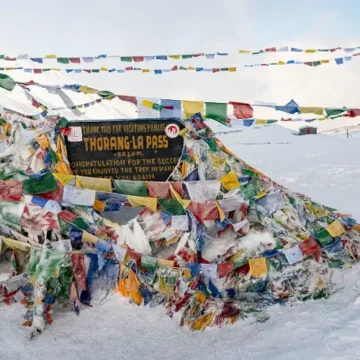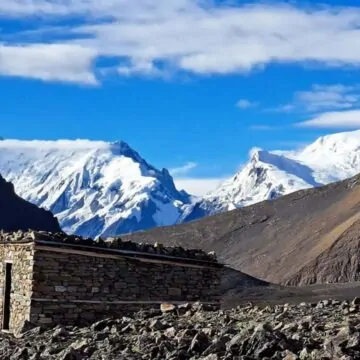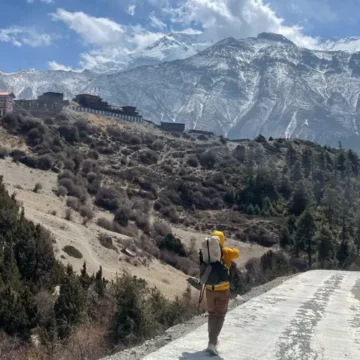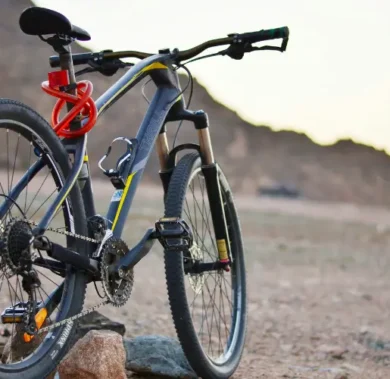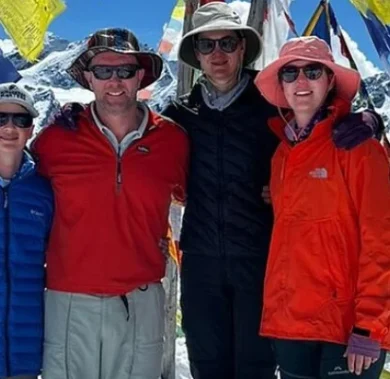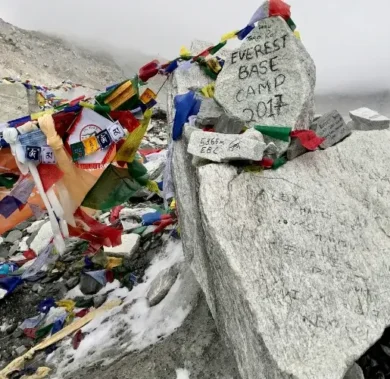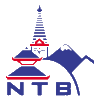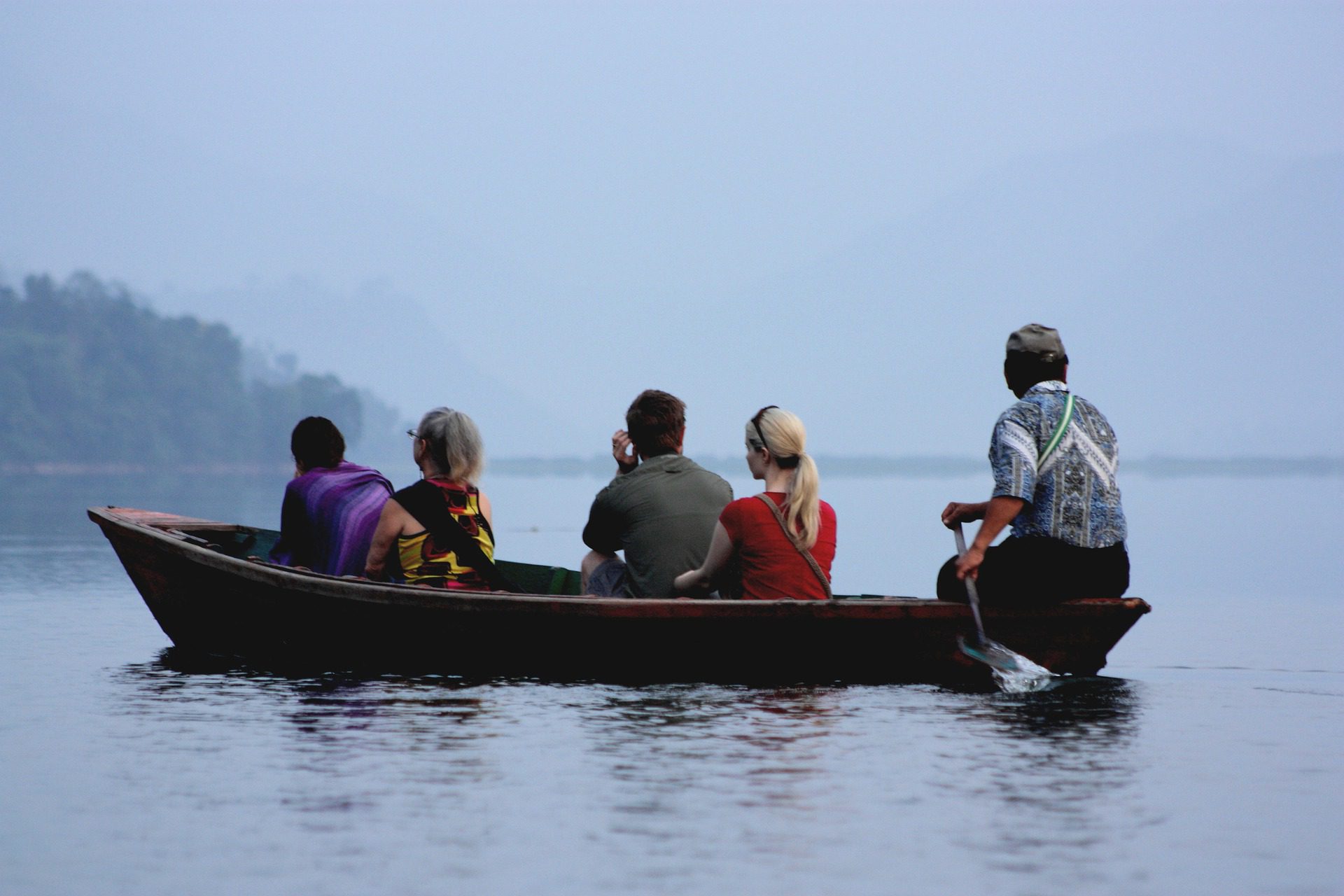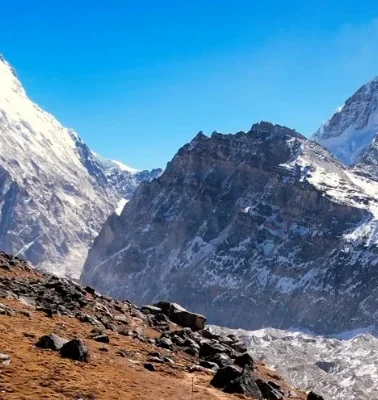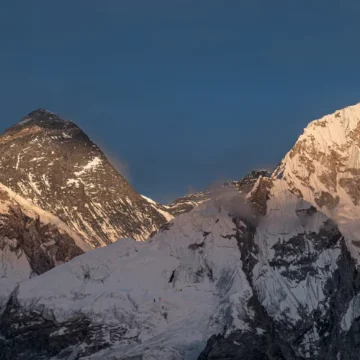
Annapurna Circuit Trek Difficulty: How Hard Is It?
Table of Contents
Suppose you are thinking of trekking around the Annapurna region. In that case, it’s likely that you have seen photos of breathtaking snow-capped peaks, pristine rivers, deep gorges, picturesque villages, friendly people, and more. But rarely will anyone show or tell you about the Annapurna Circuit Trek Difficulty.
It’s natural to be excited about the clear, never-ending blue-sky view, fluttering prayer flags in the wind, visiting ancient Tibetan monasteries, staying in locally run teahouses, and savouring Tibetan delicacies. However, all these rewards are hard-earned on the Annapurna Circuit trail.
After a long day of walking in some of the most rugged terrains of the Himalayas, then only you get to experience all these. One of the most common risks during this trip is probably the high altitude.
Nevertheless, there is nothing to worry about if you have good physical health, are fully prepared, get proper acclimatization, and are mentally strong. With proper guidance, you can complete this trip comfortably, safely and smoothly.
Overall Difficulty Rating: Moderate to Challenging
Let’s be clear here. Annapurna Circuit Trek isn’t a technical trail. However, its high-altitude passes, thin air, long walking days, and varied terrain make the trek difficult.
You won’t need any skill in using rope, ice axes, or mountaineering skills. It is also not a walk in the park, though.
Annapurna Circuit Trek difficulty for seasoned Himalayan trekkers can be easy to moderate, but strenuous. However, first-timers will feel significant physical and mental difficulty.
Some of the steepest ascents and descents are going to test trekkers’ physical endurance. And the long walking days might feel never-ending.
Nonetheless, Annapurna Circuit Trek difficulty completely depends on your preparation, fitness, acclimatization, and mindset. It’s an adventure requiring respect. But if done properly, it can be completed with near to no difficulty.
Key Factors That Affect Difficulty
There isn’t a single factor making this trek difficult, but a series of challenges that trekkers face on the way. Let’s discuss what makes the trekking Annapurna Circuit difficult.
Lack of Preparation
Probably the biggest factor increasing the Annapurna Circuit Trek difficulty is the lack of preparation. Lack of preparation will make walking on rough terrain for long hours and several days difficult.
Likewise, trekkers only expect to see mesmerizing views but do not think of the challenges that come along. They live with the challenges, and they might feel overwhelmed. Sometimes even wanting to stop the trek.
Altitude
Another key factor that affects the difficulty is the altitude. Along with physical fitness, it is essential that your body adapts to sudden increases in elevation.
The trek starts from low altitude, picturesque villages, to the staggering height of Thorong La Pass (5,416 m/17,769 ft). So, the risk of altitude sickness persists all along the route. You will be gaining about 4,000 meters of elevation within an interval of a week.
Note: Kathmandu is located at 1,400 meters (4,593 ft) elevation, and Dharapani is 1,960 meters (6,430 ft) – trailhead.
This high-altitude landscape, especially Thorong La, is going to test your resilience.
Daily Long Walking Hours and Terrain
You can expect an Annapurna Circuit Trek time of 5-8 hours daily. On some difficult terrains like Manang to Yak Kharka or Pass crossing days, it might even take 9-10 hours.
This trek will take you from stone-paved trails, flat river valleys, and dense pine forests to desert-like, steep, rocky, and barren alpine terrain. So, get ready for everything it has to offer.
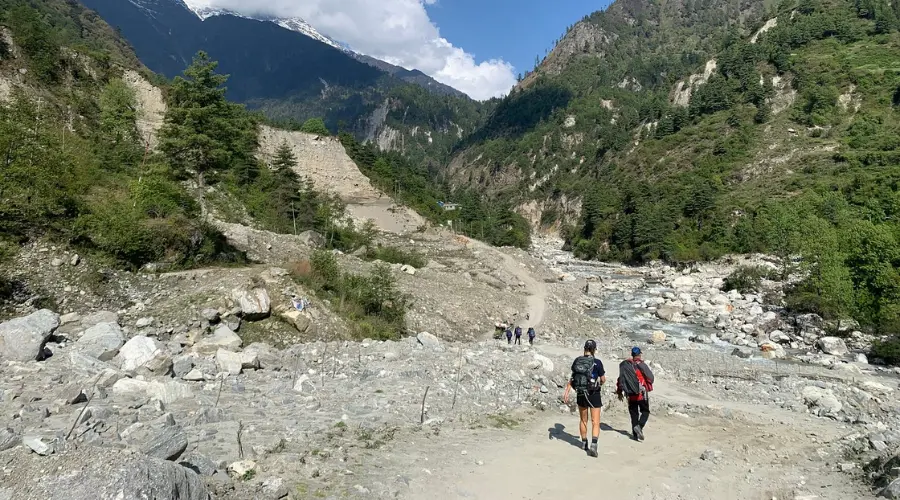
Trail Conditions
The paths in the Annapurna region are comparatively easy and well-marked. However, dusty roads, muddy trails, or even snow-covered paths can make the trek challenging.
During peak trekking seasons (spring and autumn), the route up to Manang is often accompanied by jeeps, making it dusty. Likewise, during snow, especially at higher elevations, the route might be blocked with snow.
These trail conditions might be upsetting for many trekkers. Also, it’s going to slow your pace and make it more physically demanding.
Weather Extremes
The Annapurna Circuit weather is notoriously unpredictable. Even during the Annapurna Circuit trek best season, you can expect sudden weather changes. Be prepared for sunny skies, high winds, snow, and sometimes rain. You can expect all four seasons in just one day.
Poor weather can not only make the walk uncomfortable but also pose safety risks, especially at high altitudes.
Accommodation
Do not expect your accommodation to be any star hotel or lodge. You chose this trek for authentic, raw Himalayan experiences.
You’ll be staying in a locally run teahouse. The accommodation in the Annapurna Circuit route is pretty basic but decent enough. They provide a cozy bed and nutritious meals. These teahouses are a part of the Himalayan experience.
Moreover, make sure you have a good night’s sleep. It’s vital for rest and recovery. If you’re not well-slept, it’s going to add to the trek’s difficulty.
Weight of the Luggage
The weight of the luggage is often ignored as the Annapurna Circuit Trek difficulty factor at the beginning. You might not even notice them first 1 or 2 days. But as you trek higher and feel exhausted, you’re going to feel the toll on your shoulders due to its weight.
Also, if you don’t consider packing wisely and throwing in everything you feel like, we assure you that it will be a nightmare and often expensive, too.
So, always do thorough research and consult with your trek organizer about what to pack and what not to. Hiring a porter is the best way to be relieved of the weight of your luggage.
Presence of Insects in Lower Villages
Though rare, in lower-elevation villages like Dharapani and Tatopani, you might find some mosquitoes, leeches and other insects. Especially during the monsoon season, mosquito and leech bites are a possible risk. But they are rare in high Himalayan regions.
Difficulty in Navigation
While the trail is well-marked, it might be confusing in some sections, especially if you’re a first-time trekker. So, hiring a licensed, experienced guide is a must. They will not only help in navigation but also in managing logistics, reading weather patterns, deciding what to do further, and helping in case of health emergencies.
People Also Search For: How to Use a Map and Compass on Remote Trails
Mental Exhaustion
The Annapurna Circuit Trek difficulty is 50% physical and 50% mental. It means this trek is as mentally exhausting as it is physically demanding.
You will be disconnected from the internet, and sometimes there might be no electricity. Days can feel endless. Isolation, freezing cold, and fatigue are going to wear you down mentally.
But, deciding to trek in the Himalayas is all about enjoying the Himalayan lifestyle, enjoying the moment in real, not just through your mobile screen.
Logistical Challenges
As your trek starts, you are already on a deep circuit route into remote wilderness. Availability of trekking gear and medical services is limited. In case of any emergencies, the feasible and fastest but expensive way of rescue is a helicopter evacuation. So, carrying a basic medical kit is a must.
Also, in case you forget to pack any gear or your gear breaks, you might not always find a replacement. Even if you find them, they are going to be expensive.
Water and Food
Drinking clean water and eating healthy are vital when trekking.
When trekking, your body dehydrates quickly, so proper hydration is important. If not, you will feel lazy, tired, and drained, being unable to further continue the trek.
Likewise, it is natural for your taste palate or stomach to find it difficult to adjust to Nepali or Himalayan tastes. As a result, you might fall sick; food poisoning and diarrhea are the most common problems that you might face. This can be the most annoying challenge during trekking, sometimes even needing a helicopter evacuation.
How to Make the Trek Easier?
Here are some of the tips that you can follow to make your trek easier:
- For physical preparation, we suggest you engage in strength and stamina-building exercises like running, swimming, cycling, etc., to prepare for long walking days. Along with that, exercise your legs. For that, you can do lunges, squats, etc.
- As for mental preparation, engage yourself in short, high-altitude hikes so that you know what to expect on the Annapurna trail.
- Your trek itinerary must include rest days for acclimatization.
- Do not rush; have a steady but continuous pace. Include breaks when walking, allowing your body and legs enough rest.
- Hire a guide for insight on the route, a well-managed trek, accommodation booking, and read weather patterns. Local guides can help you avoid road sections and take you through more immersive trekking trails.
- We suggest you hire a porter as they will carry all your luggage and let you enjoy the trek to the fullest. You only carry your small daypack.
- Have a steady pace and acclimatize properly.
- Choose ideal trekking seasons like spring and autumn.
- Smart layer packing according to weather is advised. Pack as light as possible.
- Stay hydrated, drink at least 3-4 litres of water daily.
- Eat nutritious, fresh, and easily digestible food. Avoid eating meat in higher elevations, as they might not have a proper refrigeration system.
- Get travel insurance that covers high-altitude trekking up to an elevation of 6,000 meters, medical bills, and helicopter evacuation.
- Use insect repellent to avoid insect bites.
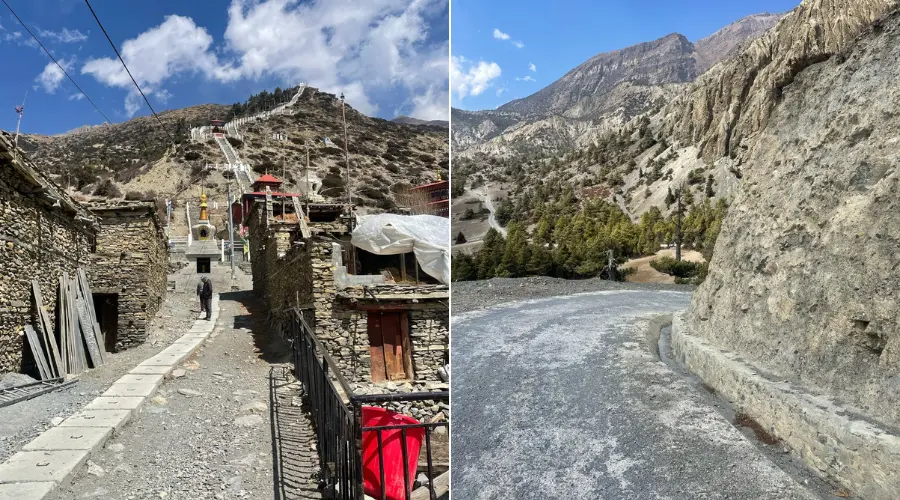
Who Can Do the Annapurna Circuit Trek?
Despite the Annapurna Circuit Trek difficulty, this route is quite achievable. People from every age group can do this trek.
Beginner Trekkers:
Even a beginner with no prior experience and decent physical condition. However, with no preparation, it’s going to be really difficult. So, thorough physical training for at least 3-4 months is a must. Also, hiring an experienced guide and a porter would be a wise choice.
Intermediate Trekkers:
If you have a few experiences of multi-day hikes, then the Annapurna Circuit Trek is the one for you. You can enjoy the natural beauty complemented by Tibetan Buddhist culture. However, do not underestimate the trail. Give enough rest to your body and acclimatize properly.
Advanced Trekkers:
For those who have already completed the Everest Base Camp Trek or the Three Passes Trek, Annapurna is the perfect destination for you. Away from the commercial Everest region, Annapurna is still raw and thrilling. Even if you can, do not rush. You might want to extend your trek towards Tilicho Lake (4,919 m/16,138 ft) for a more adventurous and raw trekking experience.
Extending the Annapurna Circuit Trek to Tilicho Lake
Adding the Tilicho Lake Trek to your original trek itinerary can significantly increase its difficulty. But the experience is immeasurable.
The route to Tilicho Lake extends from Manang Village for an additional 3 to 4 days. The Tilicho Lake route passes through the authentic Tibetan village of Khangsar and finally leads to a turquoise-blue lake.
This route traverses through a rugged, scree trail and landslide-prone areas. So, you need to be focused and control your nerves. All these challenges reward the most pristine lake view, mirroring the Annapurna range.
This route is considered more challenging and dangerous than Thorong La. It’s best not to try this route without an experienced guide.
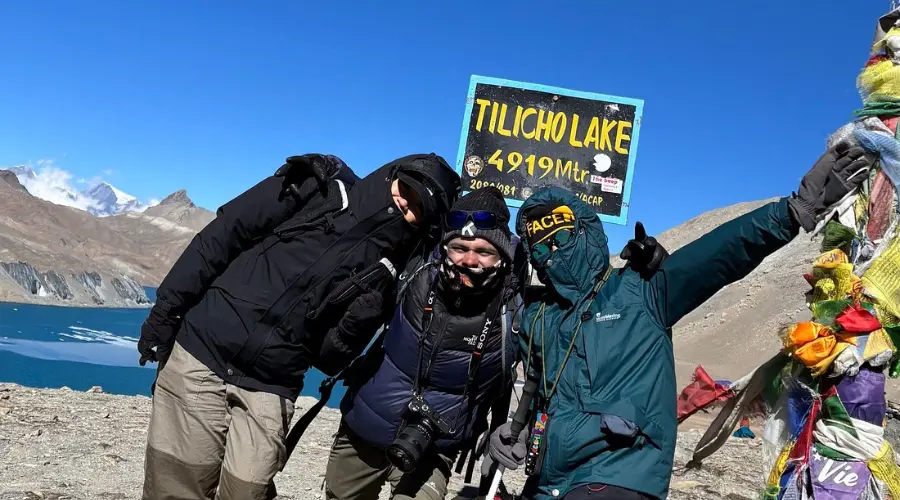
Is Thorong La the toughest section in the Annapurna round trek?
No doubt, Thorong La Pass (5,416 m) is the toughest section in the entire Annapurna round trek route. It is the ultimate, final section on the trek that really challenges your physical endurance, determination, and technical skill.
Trekkers usually start this day’s trek as early as possible, normally around 5-6 am. The weather on the Thorong La Pass can change at any time. It can change from good to bad within hours, especially around noon. Due to this, trekkers are advised to cross this section in the morning when the weather is favourable.
Make sure you are perfectly fit, both mentally and physically. The steep ascent from Thorong Phedi to Thorong La, followed by the toughest descent down to Muktinath, breaks even the strongest.
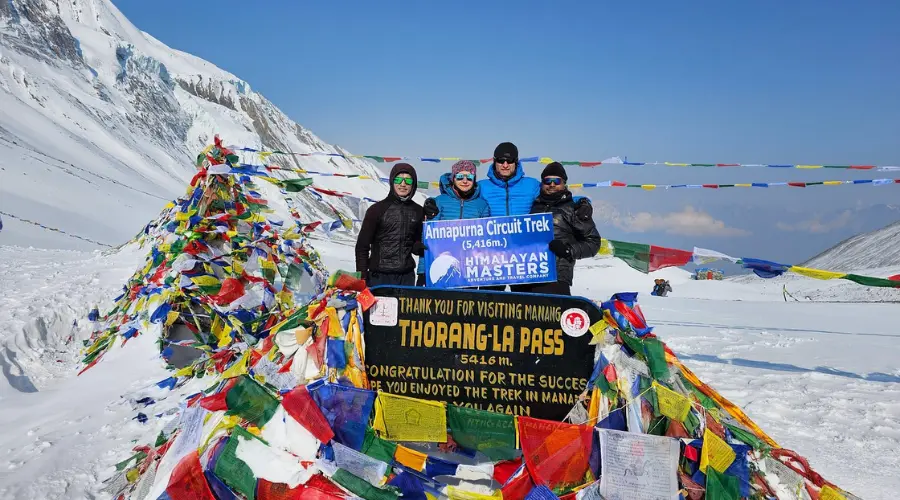
Annapurna Circuit Trek – Day-by-Day Breakdown
Here’s a day-by-day breakdown of the Annapurna Circuit Trek and its difficulty.
| Day | Route | Elevation | Difficulty Level | Notes |
| 1 | Drive from Kathmandu → Besisahar → Dharapani | 1,400 m → 1,960 m | Easy (Mentally tiring) | A full day of jeep ride along winding roads. Rest well before the trek starts. |
| 2 | Trek from Dharapani → Chame | 1,960 m → 2,710 m | Moderate | First real day of trekking. Gradual forest trails and steady ascent. Start feeling the thinner air. |
| 3 | Trek from Chame → Pisang | 2,710 m → 3,300 m | Moderate to Tough | Steeper climbs and rougher terrain. Weather starts getting colder. Breathtaking landscapes. |
| 4 | Trek from Pisang → Manang (via Ngawal) | 3,300 m → 3,540 m | Moderate (High Altitude) | Trekking via Ngawal makes the trail more scenic and tougher. Altitude symptoms might begin here. |
| 5 | Acclimatization day in Manang | 3,540 m | Easy (but essential) | Short hikes to Ice Lake or Gangapurna Lake help acclimatize. Drink lots of fluids. |
| 6 | Trek from Manang → Yak Kharka | 3,540 m → 4,050 m | Moderate | Short but steep climb. Feel the effect of altitude—slow and steady is key. |
| 7 | Trek from Yak Kharka → Thorong Phedi | 4,050 m → 4,525 m | Moderate to Tough | Altitude is challenging here. Save energy for tomorrow’s big climb. |
| 8 | Thorong Phedi → Thorong La Pass (5,416 m) → Muktinath | 4,525 m → 5,416 m → 3,760 m | Very Hard | Most difficult day. Steep ascent in thin air, freezing temperatures, early morning start. Descent is tough on knees. |
| 9 | Drive from Muktinath → Tatopani | 3,760 m → 1,200 m | Easy (but bumpy) | A long off-road jeep journey. Hot springs in Tatopani help relax sore muscles. |
| 10 | Drive from Tatopani → Pokhara | 1,200 m → 820 m | Easy | Comfortable drive day. Relax by Fewa Lake and celebrate the trek completion. |
| 11 | Drive from Pokhara → Kathmandu | 820 m → 1,400 m | Easy | Scenic highway ride back to Kathmandu. Option for flight if pre-booked. |
FAQs
Is Annapurna Circuit harder than the Everest Base Camp (EBC) Trek?
While both treks are challenging, due to Annapurna Circuit’s longer trail, higher passes, and less commercial than EBC, trekkers find this route harder.
Can children or older trekkers complete the Annapurna Circuit?
Yes. Anyone with good physical condition and well-preparedness can complete the Annapurna Circuit.
What happens if I can’t cross Thorong La?
If you are stuck at Thorong La due to bad weather, wait for better weather or turn back via Yak Kharka. However, if due to injury, helicopter evacuation might be the only option.
What’s the hardest day of the Annapurna Circuit Trek?
Thorong La Pass Day, Thorong Phedi to Muktinath, is the hardest day of the Annapurna Circuit Trek.
How long does it take to cross Thorong La Pass?
Trekkers usually start the Thorong La Pass crossing early in the morning, usually taking 8-9 hours to complete the trip.
Ace the Annapurna Circuit Trek Difficulty With Himalayan Masters
Annapurna Circuit Trek difficulty is relative. It is easy for experienced and prepared trekkers. Meanwhile, it is moderate for occasional trekkers with average physical fitness, while it is difficult for beginners with no prior preparation.
However, with Himalayan Masters, we provide the most comfortable and safe trekking itinerary, along with all the logistical support. Whether you are a beginner or an experienced trekker, we assure you that you will find the best Annapurna has to offer. From staggering peaks to rich Tibetan culture, you will not miss anything.
Remember to ping us at our email ([email protected]) or via WhatsApp (+977-9823636377).
Want to know more?
Speak to an Expert





Sandip Dhungana
Nepal 🇳🇵
Whatsapp: +977-9823636377

